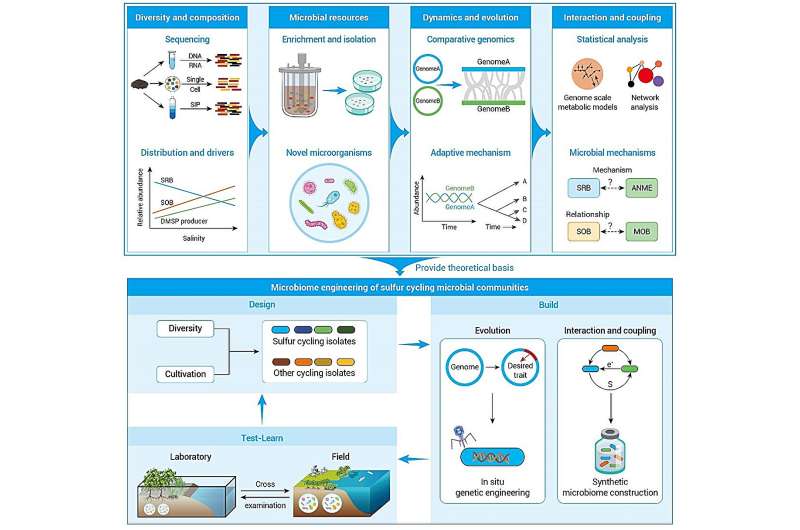This article has been reviewed according to Science X's editorial process and policies. Editors have highlighted the following attributes while ensuring the content's credibility:
fact-checked
proofread
Sulfur-cycling microbes could lead to new possibilities in river-wetland-ocean remediation

Nutrient cycles such as the carbon, nitrogen, phosphorous and sulfur cycles are critical processes that free up elements essential to life by recycling them through our water, air, and soil. Sulfur, specifically, is an integral element in producing amino acids, vitamins, and enzymes.
A recent review by scientists from Sun Yat-sen University in China looked at research done on the high sulfur cycling (s-cycling) in a river-wetland-ocean continuum (RWO), which is largely mediated by microbial communities. While sulfur itself is an important element, just as critically, its cycle can mediate the carbon and nitrogen cycles, influencing carbon sequestration and greenhouse gases.
The review was published in Ocean-Land-Atmosphere Research.
"The S(ulfur)cycle in natural environments is usually coupled with other element cycles and has important implications for mediating global climate change and biogeochemical cycling. Therefore, unraveling the functional genes, microorganisms, and coupling mechanisms involved in S cycling has critical environmental importance, especially in the river–wetland–ocean (RWO) continuum, which is considered a key zone of matter and energy cycling," said Xiaoli Yu, first author and a scientist at the Environmental Microbiomics Research Center, the School of Environmental Science and Engineering, Southern Marine Science and Engineering Guangdong Laboratory (Zhuhai), State Key Laboratory for Biocontrol, Sun Yat-sen University, Guangzhou, China.
The RWO continuum is a transitional area where very different environments meet. As a result, it is a very dynamic environment with salinity gradients between the river and the nearby ocean, ocean tidal effects, sediment movement, and frequent nutrient exchange. To add further complexity, they are often highly urbanized areas, with 60% of China's gross domestic product coming from economic activities in coastal areas, which can put significant pressure on those organisms living within the RWO continuum.
This diversity of environments supports a wide variety of microbes, many of which use the abundant sulfur for their own biological processes, thus becoming part of the sulfur cycle. While there has been much research done to catalogue and study these microbes, there are still many areas that need addressing.
The researchers "propose a conceptual framework for further understanding the diversity and composition, novel cultivation methods, dynamics and evolution, interaction, and coupling mechanisms with a focus on microbiome engineering of S-cycling microbial communities to improve ecosystem functioning based on the current knowledge in the RWO continuum," said Zhili He, corresponding author and professor of Environmental Microbiomics Research Center, School of Environmental Science and Engineering, Southern Marine Science and Engineering Guangdong Laboratory (Zhuhai), State Key Laboratory for Biocontrol, Sun Yat-sen University, Guangzhou, China.
Specifically, they recommend a multi-dimensional research strategy aimed at understanding diversity in the s-cycle microbes that inhabit the RWO continuum. The development of new cultivation methods would thereby allow the description and elucidation of specific sulfur processes among the many different s-cycle microbes. They also recommend that more work be done to understand their life strategies, communities, and the adaptations that allow them to exist in the diverse and dynamic environment created by the RWO continuum.
Finally, they recommend using what we know now, in conjunction with future research studying s-cycle microbial biology, the interactions between various microbial species, and the links between the RWO s-cycle and the carbon and nitrogen cycles, to build models of the RWO continuum.
The models can then be used to run simulations of differing environmental or ecological conditions to determine how to strengthen and enhance these microbial communities. Once tested and proven within the simulations, the results can be used in real-world scenarios to modify and help the naturally occurring microbiome; this is called microbiome engineering.
There is still much work to be done in the RWO continuum. "The exploration of the diversity, cultivation, evolution, interaction, and coupling mechanisms of S-cycling microorganisms will provide a theoretical basis for microbiome engineering and potential applications in the RWO continuum. Microbiome engineering aims to improve ecosystem function, such as human health and agricultural productivity, by manipulating the microbial community," Hu said.
More information: Xiaoli Yu et al, Microbially Driven Sulfur Cycling in the River–Wetland–Ocean Continuum, Ocean-Land-Atmosphere Research (2023). DOI: 10.34133/olar.0027
Provided by Ocean-Land-Atmosphere Research (OLAR)




















